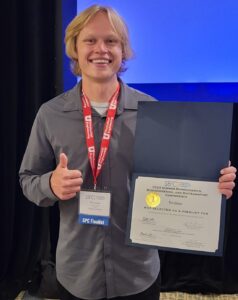 University of Utah Department of Mechanical Engineering undergraduate student Tim Dixon won 1st place in the Bachelor’s level student paper competition at the Summer Biomechanics, Bioengineering, and Biotransport Conference (SB3C). Student attendees submit a 2-page abstract consisting of research completed by the student. The abstract is reviewed and scored by a panel of judges. Top-scoring abstracts are asked to present posters at the conference, where anonymous judges evaluate the presentation and research. Out of 45 submissions, Dixon was selected as the winner in the Image-Based Measurement, Analysis, and Modeling category.
University of Utah Department of Mechanical Engineering undergraduate student Tim Dixon won 1st place in the Bachelor’s level student paper competition at the Summer Biomechanics, Bioengineering, and Biotransport Conference (SB3C). Student attendees submit a 2-page abstract consisting of research completed by the student. The abstract is reviewed and scored by a panel of judges. Top-scoring abstracts are asked to present posters at the conference, where anonymous judges evaluate the presentation and research. Out of 45 submissions, Dixon was selected as the winner in the Image-Based Measurement, Analysis, and Modeling category.
Dixon’s work titled, “Optimization of objective measurements for evaluating sagittal synostosis detection and treatment efficacy,” collaborated with Jason Ramsey and Phillip Stevens from the Hanger Clinic to look at new metrics for diagnosing and tracking the treatment of sagittal synostosis (SS). SS is the premature fusion of one of the bones in the skull during an infant’s development. Currently, it’s diagnosed using a single metric, called cephalic index, that compares the width of the baby’s head to the length, which introduces a lot of subjectivity and fails to capture many features important to diagnosis.
“No single metric can accurately identify all abnormalities, highlighting the need for a multi-metric approach,” said Dixon. “The results of the study found that an optimized set of 3 metrics were 96% effective at identifying SS, whereas the original method only correctly identified 80% of SS cases. The new metrics were also much more sensitive to tracking treatment over time.”
These results will improve the state of the art in identifying and treating SS, which can have serious consequences, including impairment of brain development. The earlier and more accurately it can be diagnosed, the better the treatment.
“The new metrics, and the program I wrote, can be run on any computer in seconds,” said Dixon. “It calculates the metrics from 3D optical scan point-cloud data and can objectively determine concern for SS. The program can also be used to track results, ensuring that treatment is working and even evaluate the rate it’s working at.”
This research was done in the Utah Head Trauma Lab with Professor Brittany Coats. You can find out more about the lab and the other research they do on their website: pedtrauma.mech.utah.edu.
“I’d like to thank Dr. Brittany Coats for giving me the opportunity to perform and present this research,” said Dixon, “as well as my collaborators from Hanger Clinic, and all the fellow Utes who attended the conference and made it such a great experience. SB3C was a blast and I hope I get to go to a lot more research conferences in the future.”